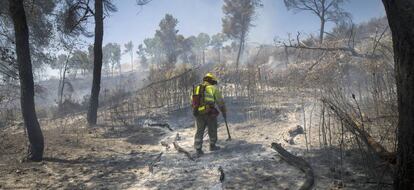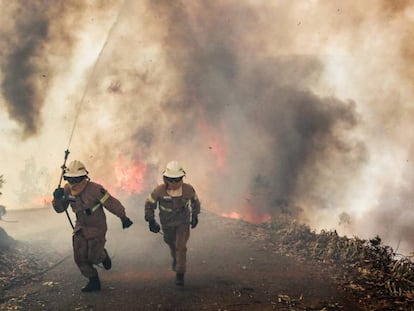The Spanish mountains where lightning really does strike twice
Huge concentration of electrical strikes causing fires on border of Valencia and Arag¨®n regions
Lightning appears to be the cause of the fire that destroyed 1,289 hectares of the Sierra Calderona, a mountain range in the eastern Spanish region of Valencia. If the ongoing investigation confirms this, it wouldn¡¯t come as a surprise. The mountain range is located at the southern tip of the area in Spain where the most lightning strikes are recorded. As a consequence of that geographic position, and because of the zone¡¯s forested nature, it is also where these meteorological phenomena lead to the most fires.

For this reason, firefighters in Valencia have become a reference point in the fight against these kinds of forest fires, of which there are two different kinds. For example, lightning can split a tree in half and instantly trigger a fire. Or, it can generate a slow and subterranean combustion, which remains hidden for a couple of days until finally showing up as a highly destructive forest fire. The combination of technology and fieldwork has allowed a forest fire research group for Valencia¡¯s regional government to learn how to deactivate these time bombs in its early stages when this kind of slow-build fire appears as a small pile of white ash in the soil that gives off a smoke cloud no larger than that of a cigar.
More than 1.3 million electric discharges strike Spain each year
More than 1.3 million electric discharges strike Spain each year. These are not necessarily synonymous with rays. The number also includes ¡°the main electric discharge that branches out to touch land at several points,¡± says Jos¨¦ ?ngel N¨²?ez, a meteorology expert. The average density of electric discharges in Spain each year is 1.2 per square kilometer. However, in this highly active area, the strike rate is 6.1 per square kilometer.
A combination of factors
This highly active area has the Sierra Calderona as a southern boundary and also includes the Sierra Espad¨¤, Sierra G¨²dar and Sierra Javalambre mountain ranges. It also contains the districts of Alcalat¨¦n, Alt Maestrat and Els Ports. The most dangerous epicenter for lightning lies between the cities of Teruel and Castell¨®n. The reason behind this, explains N¨²?ez, is due to the combination of the heat that accumulates on the surface of the mountains and the cool breeze that comes from the Mediterranean Sea.
As a whole, lightning only causes around 5% of the fires in Spain. But in Valencia and Arag¨®n it causes around 25% of fires. Some years, that figure is 40% in Castell¨®n province, where there were 36 lightning fires in 2016. And in Teruel, where the low population density makes fires caused by negligence or arson infrequent, the percentage is 80%.
¡°When the area is dry, I¡¯m more afraid of lightning than arsonists,¡± says Francisco Tejedor, head of forest fire investigation with the regional government of Valencia. ¡°Lightning can cause fires in locations that are inaccessible by land and it tends to strike at dusk so if you don¡¯t have the necessary aviation machinery, then you¡¯re lost.¡± He recalls a thunderstorm in 1991 that caused 18 fire outbreaks.
When the area is dry, I¡¯m more afraid of lightning than arsonists Francisco Tejedor, head of forest fire investigation in Valencia
The potential risks have made the region¡¯s environmental technicians specialists in preventing these fires. A local agency tracks the approximate locations of where rays have fallen each day. The information is obtained through the network of about 20 antennas set up by the meteorological agency. With this technology, they can monitor the areas of impact, particularly in times of high risk, such as the summer.
According to Juan Carlos Moragues, a representative for the regional government of Valencia, the June fire in the Sierra Calderona was caused by a lightning strike a couple days earlier. ¡°This type of burning, which we call ¡®carbonera¡¯ can be very dangerous,¡± says Moragues. ¡°When they have collected enough energy and there are optimal environmental conditions, they take off at great speed.¡±
A dry thunderstorm in 1991 caused 18 fire outbreaks
Even with the help of technology, looking for these fires in their early phases is like looking for a needle in a haystack. Tejedor shows an image of a spot of white ash surrounded by pine needles where a faint waft of smoke emerges. ¡°An observer detected the lightning at 10.07pm on July 9, 2013 and the agency confirmed that there were impacts in the area at that time, says Tejedor. ¡°It was monitored on July 10 but nothing was found, until 7.30pm that same day when the fire broke out that was then extinguished. The next day we investigated the burned area and alongside it, we found a slow combustion point without a flame. It had been hiding from 10.07pm on July 9 to 12.34pm on July 11.¡±
English version by Debora Almeida.
Tu suscripci¨®n se est¨¢ usando en otro dispositivo
?Quieres a?adir otro usuario a tu suscripci¨®n?
Si contin¨²as leyendo en este dispositivo, no se podr¨¢ leer en el otro.
FlechaTu suscripci¨®n se est¨¢ usando en otro dispositivo y solo puedes acceder a EL PA?S desde un dispositivo a la vez.
Si quieres compartir tu cuenta, cambia tu suscripci¨®n a la modalidad Premium, as¨ª podr¨¢s a?adir otro usuario. Cada uno acceder¨¢ con su propia cuenta de email, lo que os permitir¨¢ personalizar vuestra experiencia en EL PA?S.
?Tienes una suscripci¨®n de empresa? Accede aqu¨ª para contratar m¨¢s cuentas.
En el caso de no saber qui¨¦n est¨¢ usando tu cuenta, te recomendamos cambiar tu contrase?a aqu¨ª.
Si decides continuar compartiendo tu cuenta, este mensaje se mostrar¨¢ en tu dispositivo y en el de la otra persona que est¨¢ usando tu cuenta de forma indefinida, afectando a tu experiencia de lectura. Puedes consultar aqu¨ª los t¨¦rminos y condiciones de la suscripci¨®n digital.











































